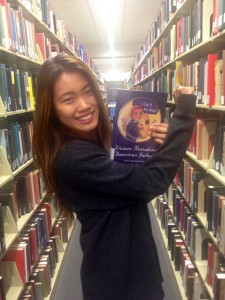
Prell, Riv. Women Remaking American Judaism. Detroit: Wayne State UP, 2007. Print.
For my second shelfie adventure, I searched for “Judaism Feminism” in the Lafayette College library catalogue because I am interested in seeing how Feminism is different in Judaism compared to popular western beliefs. After watching the documentary “Be Fruitful and Multiply”, I was surprised that most of these Jewish women believed that feminism meant taking care of the household. On the contrary, most ‘western’ feminists would exclaim that having to stay home and tend to children is a barrier for women.
After searching the words “Judaism” and “Feminism”, I came across the book “Women Remaking American Judaism” edited Riv-Ellen Prell and the first thing that I noticed was the cover. The cover depicts a Jewish woman holding a similar pose to ‘Rosie the Riveter’. ‘Rosie’ was a very famous cultural icon during WWII for the representation of American women who worked in factories in order to produce military weapons. This cultural icon is still very popular today because it is used as a symbol of feminism. The book is split into three different categories: Reenvisioning Judaism, Redefining Judaism, and Reframing Judaism. Each section contains essays by different authors who offer various interpretation of Jewish feminism. In Reenvisioning Judaism, the stories conclude that Feminist thinking challenges traditional Jewish theology. Statements such as “The Jewish legal system is constructed entirely from a male perspective” is used to showcase the challenges women face as a Jewish worshipper. Redefining Judaism showcases the changes in the role of women in American Judaism and how the changes were dependent on American societal changes. Lastly, Reframing Judaism displays how different innovations such as adult bat mitzvah ceremonies or the Miriam’s Tambourine have allowed women to create a ‘new’ Judaism in which women are equally represented as men.
Although I initially was expecting to dive more into how some Jewish women beliefs on feminist differed from western feminist beliefs, I am glad that I found this book because I now want to focus of the Jewish feminist revolution in America. I will probably use this book as one of my sources for my next paper because it contains insights on the different approaches of Jewish feminism.